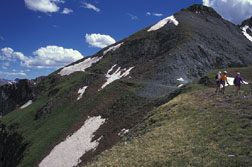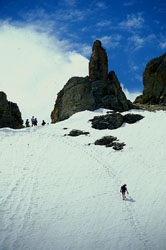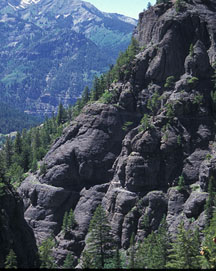Natural Devolution: The Hardrock Hundred Trail Race
In July 1999 I found my missing orthotic at 5:00 am in the middle of the street in front of the only liquor store in Silverton, Colorado. A terrific chest cold, preventing sleep, motivated this early morning search; how the insole came to rest there is another story. Still sick a few days later, I coughed and gagged my way through 85 miles of mountainous terrain, stopping 17 miles short of my goal.

Dives-Little Giant Traverse. It's steeper than it looks.
That goal was to kiss The Hardrock, a large block of rock sitting in front of the Silverton High School gym. Kissing that rock would mean that I had traveled 102 miles through the San Juan mountains in less than 48 hours, successfully completing the Hardrock 100 mile trail run. I knew I had to come back in 2000.
"Honey, I think I'd like to try doing a hundred mile trail run", I said a few years back. "Whatever you like, dear", Kathy replied. My wife likely assumed that this was part of a natural devolution from rock climber to mountaineer to ice climber to endurance athlete. I was more pragmatic; I was pretty low on climbing partners due to marriages/kids/jobs, and my career as a solo mountaineer was not limited by ethics or desire, but by technical competence.
Mix these elements together and, to make a short story even shorter, I took up trail running. I could do it alone, enjoy the solitude and beauty of the mountains, all without any real danger (or so I thought). Trail running, like climbing, has many levels of commitment. You can top-rope at Taylors Falls or climb the Moonflower Buttress; you can trot around a wood-chipped nature trail or struggle a hundred miles through rugged mountains.
Also like climbing, trail running has organized competitions. Western States and Leadville are probably the best-known of the 100 mile trail runs, but one of the most challenging races is the Hardrock 100, held in the San Juan mountains of southwestern Colorado. A climb can be quickly summarized with a few statistics: 25 pitches, 5.10d, WI4. Runners summarize Hardrock this way: 102 miles, 33,000 feet ascent, 33,000 feet descent, average elevation 11,000 feet, 12 passes over 12,000 feet, 48 hour time limit. In other words, six round trips up and down Longs Peak in two days.
It's 4 am, race day. The novelty of these events long gone, my family burrows back under the covers as I quietly dress, grab my gear, and head down the street for breakfast. The unsung heroes of these races have to be the cooks and waiters that get up in the middle of the night to feed the muy loco runners. Eggs, bacon, hash browns, toast, coffee, coffee, and coffee.
A fellow saunters over to the table and says he's doing a story for Outside magazine. He pumps everyone for angles that will make a 'good' story–runners with wooden legs, one lung, impacted testicles–though he seems somewhat disheartened that we're all so boring. "I got hit on the head with a big chunk of ice once", I offered, "and then I decided to try Hardrock." "Yeah, thanks, I'll get back to you", he muttered as he backed away slowly, looking for a real story to propel him to Krakauer-like fame and fortune.
As we started up the first climb my nose started bleeding. Now I've been blessed with fragile nasal vessels that seem to delight in rupturing at inappropriate occasions. Fewer than 50% of the starters eventually finish this event; hiking uphill at the back of the pack with a bloody wad of toilet paper sticking out of my nose, I felt like a member of the wrong half of the pack.
The sports plan is simple. Speed hike up two to four thousand feet, then descend as fast as possible. Do that a dozen times. "What do you think about for all those hours?" is a common question. The first part of the race is no problem-talking to others, planning strategy, enjoying the view. The middle part of the race is staying awake, keeping moving. The last part of the race, you can't think.
Aid stations are placed every 6-10 miles along the course. An aid stop can be a relaxed time to eat, change clothes, visit with your crew. Or it can be like a pit stop in a NASCAR race: "Number 74 is in, c'mon, c'mon, get me a sandwich, fill these bottles, where the hell is my headlamp...I'll be at the next station in four hours, see ya later, Number 74 out!"

Virginius Pass during course marking, 2000.
Near midgnight, I climb to Engineer Pass without a flashlight, navigating by moonlight and starlight.
Leaving Telluride on the second morning I caught up with Hans-Dieter Weisshaar, a 60-year old German physician who was partway through a record-breaking year of completing nineteen 100 mile trail races.
"This is the easiest race I've ever done!" he exclaimed. As we grunted up yet another multi-thousand foot climb, I thought he was a bit crazy. On second thought, maybe attitude is everything.
The biggest challenge in the last 25 miles is climbing Grant-Swamp Pass. The pass is guarded by cliffs of rotten volcanic rock, seamed by gullies that are unfortunately free of snow at this time of year. The remaining soil and gravel is at the angle of repose, forming slopes of 'technical dirt'.
Several other runners were groveling up the slope above, and a few decided to move onto the 'solid' rock to the right. Being a crafty veteran climber I moved off to the left, well out of the fall line of any rocks that might come down. Or so I thought.
One participant, who shall remain nameless, decided to surmount a short section of near-vertical rock at the top of the pass. "Get away from there!" I yelled, "you're going to..." and a microwave-sized block falls, but not the climber.
I'm a bit jumpy about falling rocks. If you've ever laid under a CAT scanner listening to the whoosh, whoosh of pictures being taken of slices of your brain after being hit by rockfall, you'd be jumpy too.

Bear Creek, just above Ouray. It's always dark here for me.
A well-mannered rock would have fallen straight down as I safely watched from the side. This one bounced once, change directions, then shattered into a bunch of pie-sized discs that came straight at me. Too tired to run, nowhere to hide, I deked left and right as the volley passed on both sides, feeling the rush of wind as each piece spun by. In five seconds it was over.
It took me about two minutes to reach the top of the gully, remembering that really crafty climbers know that speed is safety. "Well, it can't get any worse than that", I muttered to a fellow traveler as we started down the other side of the pass.
It got worse.
Only one more uphill stretch-barely 1000 feet-to the final seven-mile downhill to the finish. Simultaneously the sun set, the clouds descended, and the rain turned to hail. At this point it's important to describe how the course is marked. Reflective tags about the size of a credit card are attached to wire stakes about two feet long. With a good light you can see these a hundred yards away or more.
A fellow runner stopped and waited for me. He had one of those new LED lights, which are great for reading but cut through fog like a spoon through a steak. "Where's the next marker?" he chattered through clenched teeth-it really wasn't good weather for shorts."I dunno. I'll stand by this one and you go look". He wandered away."I found it," he yelled, after a short search. "Come on up."
And so we went. Eventually I went first with my brighter light, leading a very short tango line up to nearly 13,000 feet, cutting through fog that would be considered thick on the English moors. At one point we were stumped. The next marker was nowhere to be found and the storm was, if anything, getting worse."What's that reflection up there?"
"It can't be a marker. It's 30 feet off of the ground!"
"Must be a piece of old mining gear with something reflective on it."
"But where's the marker?"
Finally my partner decided to walk over to the 'mining equipment' and look at it. "There's a trail over here. Come on!"
The trail turned sharply and climbed a short hill to the marker. There was no mining equipment in sight. A half hour later we stumbled into the final aid station, 7 miles from the finish. The tent had collapsed in the storm, but the resourceful staff had propped it up enough to use. Refreshed by the hot drinks at the aid station we started down the final stretch, 40 hours and 95 miles from the start.
"By the way, what' your name?"
"Mike."
"Yeah, mine too."
With the storm behind us and the trail easy to follow, my brain decided to take a break from the action. The hallucinations were spectacular-rocks became basketballs, trees became walls, boulders became chairs. And there were lots of people hiding behind the trees, though none of them came out to talk to me.
We drag into the high school gym less than 44 hours after the start. It's about 1:40 am.
"What took you so long? We've been waiting for a couple of hours," my wife yawned.

The finish, after 43.7 hours.
The winner, Kirk Apt, finished in 29:35, a new course record, which is a pace of 3.4 miles per hour. I finished in 43:37, at a 2.3 mph pace. Was I satisfied? Was that my best effort?
As we left the awards ceremony, I made motel reservations for next year. Just in case.
Postscript: I did come back in 2001. Aside from a terrifying lightning storm at 12,000 feet on the exposed flank of Buffalo Boy ridge (mile 85), it was a good race. Finished in 40:07 with no crew or pacer (but the Finney and Knutson crews, and Ginny LaForme & Co. gave crucial support). Time to take a year off!
